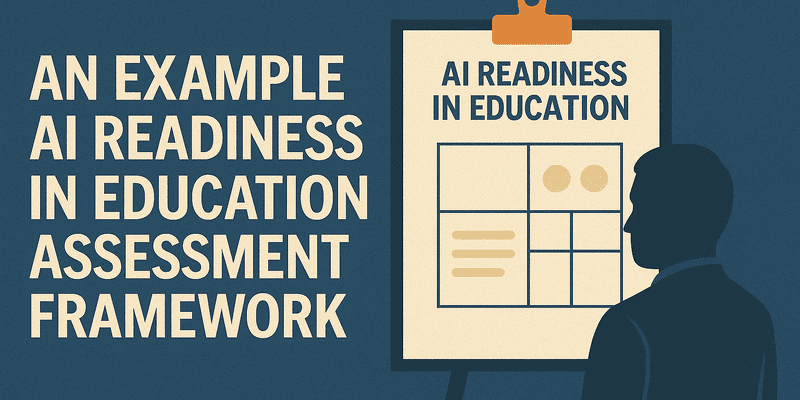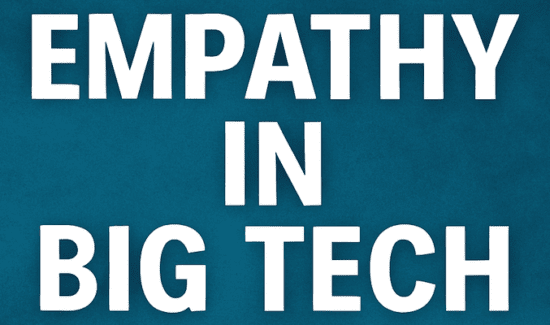An Example AI Readiness in Education Assessment Framework

Tim King offers an example AI readiness in education assessment framework, part of Solutions Review’s coverage on the human impact of AI.
Artificial intelligence is reshaping the world—but education must decide how it will shape AI in return. While tech companies race to embed AI into every facet of digital life, from content creation to diagnostics, schools and universities face a more fundamental challenge: How do we prepare students for an AI-driven future without surrendering the values that define learning?
Preparing the Classroom for the Age of AI
The answer lies not in blind adoption or knee-jerk resistance, but in readiness—a deliberate, thoughtful, and principled approach to AI integration that centers students, supports educators, and safeguards the mission of education itself. AI tools may help personalize learning, improve grading efficiency, and enhance tutoring—but without ethical governance, oversight, and community input, they also risk deepening inequity, eroding trust, and automating harm.
This comprehensive AI Readiness in Education Assessment Framework is designed to help institutions—from K-12 to higher education—navigate this challenge. It breaks readiness into clear pillars: from pedagogical alignment and data privacy to faculty skills and student feedback loops. Each section includes a tool-based call to action to help administrators, educators, and policymakers move from theory to implementation.
Whether you’re a district superintendent, a university CIO, or a teacher wondering how AI will change your classroom, this framework will guide you in asking the right questions, avoiding the common pitfalls, and building systems that serve students—not just systems that impress vendors. AI can support learning—but only if we lead its adoption with integrity, transparency, and care.
Important: AI Won’t Replace You, But Lack of Soft Skills Might – Get Report
AI Readiness in Education Assessment Framework
AI Readiness in Education: Strategic Vision & Educational Mission Alignment
Before adopting any AI tool, educational institutions must ask: Does this technology support or subvert our core mission? The goal of education is not efficiency—it’s enlightenment. AI readiness starts with aligning AI use to institutional values, learning outcomes, and the broader mission of equitable, holistic student development.
Too often, AI adoption in education is driven by vendor marketing, budget surpluses, or a desire to appear innovative. But chasing “edtech for the sake of edtech” can lead schools to install tools that prioritize automation over pedagogy, surveillance over safety, and performance metrics over human development. A readiness framework helps schools reject tech-solutionism in favor of tech-alignment.
Strategic alignment means ensuring AI supports:
-
The learning goals of the curriculum (not shortcuts or distractions)
-
The human development of students—cognitive, emotional, ethical
-
The values of the institution—equity, inclusion, inquiry, dignity
AI tools should amplify great teaching, not replace it. They should help identify and support struggling students, not profile or stigmatize them. And most importantly, they should never narrow the purpose of education to algorithmic outputs.
Creating this alignment means involving educators, administrators, students, and even parents in defining how AI fits into the classroom—not just letting vendors define that for you.
AI Readiness in Education: Stakeholder Readiness & Institutional Governance
No AI system in education is truly ready unless the people it affects most—students, teachers, parents, and administrators—are involved in shaping how it’s used. Technology alone cannot improve education. What matters is how it’s adopted, governed, and trusted. That’s why stakeholder readiness and institutional governance are foundational to AI readiness in schools, colleges, and universities.
Stakeholder readiness begins with awareness. Do educators understand how AI tools work, what data they use, and what their limitations are? Are students and parents informed when AI is used to make or assist decisions about learning outcomes, discipline, or personalization? Is there space for community dialogue and consent—or is AI being introduced behind the scenes?
Institutional governance is the structure that ensures these questions aren’t just asked once, but continuously. An empathetic, responsible approach to AI requires that institutions create formal governance mechanisms—task forces, advisory councils, or oversight boards—that bring together diverse voices to evaluate, approve, monitor, and revise AI use.
Strong governance frameworks help ensure:
-
Teachers are involved in selecting and shaping AI tools, not sidelined by top-down procurement.
-
Students and families have a say in how data is used and how tools impact learning experiences.
-
Oversight bodies are empowered to pause or reject tools that do not meet ethical, pedagogical, or legal standards.
This is particularly crucial in education, where power imbalances are already present. A lack of governance can turn AI into a force for automation and control; effective governance turns it into a force for inclusion, improvement, and partnership.
Institutions must also prepare for long-term cultural integration. That means offering onboarding for new stakeholders, continuous communication about AI decisions, and well-publicized policies on rights, appeals, and accountability.
AI Readiness in Education: Curriculum & Pedagogical Integration
Artificial intelligence is not a magic wand. In education, it must be thoughtfully integrated into curriculum and pedagogy—not layered on top of existing systems or used as a shortcut for deep, human-centered learning. AI readiness in education means evaluating not only what technology can do, but what it should do—pedagogically, ethically, and developmentally.
Before any AI tool is deployed, educators and curriculum leaders must ask: Does this tool genuinely support our instructional goals? Does it foster deeper understanding, critical thinking, and creativity—or does it encourage passive consumption and reliance on automation?
Examples of thoughtful integration include:
-
AI-assisted feedback tools that help teachers provide personalized guidance at scale—while still allowing for human oversight and nuance.
-
Adaptive learning platforms that tailor lesson difficulty based on student progress—used in a way that aligns with curriculum standards and avoids narrowing the scope of learning.
-
Language generation tools that help students brainstorm or practice writing—paired with strong instruction in authorship, ethics, and fact-checking.
AI should never replace the educator’s judgment. It should complement it. When tools are misaligned—like grading algorithms that value speed over reasoning, or recommendation engines that reinforce bias—they can undermine student motivation, reduce autonomy, and compromise learning outcomes.
Pedagogical integration also means preparing students for a future where AI is everywhere. This includes helping students develop AI literacy, understand its strengths and flaws, and reflect on ethical uses. Education shouldn’t just be about learning with AI—it should be about learning about AI.
AI Readiness in Education: Faculty & Staff Capability Building
No AI system will transform education unless educators are empowered to use it with confidence, discernment, and purpose. That’s why faculty and staff capability building is a non-negotiable pillar of AI readiness in education. Teachers are not passive recipients of technology—they are its stewards, interpreters, and frontline ethicists. If they are unprepared, even the most powerful AI tools will falter—or worse, be misused.
AI literacy must extend beyond a basic introduction to ChatGPT or auto-grading tools. Faculty need structured training that addresses:
-
Technical fluency: Understanding how AI systems work, their inputs, limitations, and failure modes.
-
Pedagogical relevance: Knowing when and how AI tools can support learning without compromising instruction.
-
Data ethics and student rights: Recognizing what constitutes responsible use of student data, especially for minors.
-
Bias recognition and mitigation: Identifying when algorithms might be reinforcing inequalities or misleading educators.
-
Communication and transparency: Explaining to students and parents how AI is being used in the classroom.
This training cannot be an afterthought. It must be integrated into onboarding, professional development days, and ongoing certification requirements. IT teams must also be equipped to support new AI systems and ensure their safe operation, from integration to incident response.
Importantly, capability building is not just about absorbing new information—it’s about empowering educators to question, adapt, and even reject AI tools that don’t serve students well. It is the frontline defense against automation without understanding, and the foundation for empathy-driven technology use.
Institutions that invest in this readiness gain more than functionality—they gain trust. When faculty feel informed and supported, they can innovate responsibly. When they don’t, adoption stalls, misuse spreads, or backlash grows.
AI Readiness in Education: Data Privacy, Consent & Student Rights
At the heart of any AI system is data—and in education, that data often comes from children, teenagers, or vulnerable adult learners. This makes data privacy, informed consent, and student rights not only a legal requirement, but a moral imperative. AI readiness in education demands a rigorous, proactive approach to protecting the privacy and dignity of every learner.
Many AI-powered education tools rely on sensitive personal information: grades, attendance, learning styles, behavioral patterns, even biometric data in some cases. Without strong safeguards, this data can be misused, sold, leaked, or exploited—putting students at risk and schools in legal jeopardy.
Compliance with laws like FERPA (Family Educational Rights and Privacy Act), COPPA (Children’s Online Privacy Protection Act), and GDPR (for international students) is essential—but it is the floor, not the ceiling. Institutions must go beyond minimum standards to ensure that:
-
Students and guardians are fully informed about what data is collected, how it is used, and with whom it is shared.
-
Consent is meaningful, not buried in fine print or forced by default for accessing core services.
-
Data minimization is enforced—only the data necessary for educational value is collected.
-
Vendors are held to strict privacy agreements, with auditability, deletion rights, and breach notification protocols built in.
-
Students have the right to review and challenge data-driven decisions, especially in areas like grading, behavioral scoring, or academic placement.
Empathetic AI governance in education treats student data as sacred. It avoids turning learners into data points, or classrooms into surveillance zones. It promotes trust, which is foundational to any successful learning environment.
To be AI ready is to understand that every algorithm built on student data carries both potential and responsibility. The question is not “Can we collect this?”—but “Should we?” and “Do students and families know enough to say yes?”
AI Readiness in Education: Equity, Accessibility & Algorithmic Fairness
Artificial intelligence has the power to amplify opportunity—or to widen educational divides. If not carefully designed and deployed, AI systems can replicate existing inequalities, reinforce stereotypes, and deny critical resources to the very students who need them most. That’s why equity, accessibility, and algorithmic fairness must be core pillars of AI readiness in education—not afterthoughts.
Bias in AI doesn’t happen by accident. It happens when algorithms are trained on data that reflect social injustices, when performance is optimized for the majority rather than the margins, or when systems are deployed without testing across diverse learning populations. In education, that bias can show up in:
-
Automated grading tools that under-score students from non-dominant language backgrounds
-
Predictive systems that flag behavioral risk based on race, ZIP code, or socioeconomic status
-
Tutoring platforms that don’t accommodate students with learning disabilities or assistive tech needs
True AI readiness requires institutions to ask: Is this tool equally effective and accessible for all learners? If the answer isn’t a resounding yes, it’s not ready.
Accessibility also extends beyond disability inclusion (though that’s critical). It includes socioeconomic access, language support, internet access, and cultural responsiveness. A tool that works well for an English-speaking student with a MacBook at home must also work for a multilingual student using a school-issued Chromebook.
Institutions must build a culture of fairness from the start by:
-
Mandating fairness audits before deployment
-
Requiring vendors to disclose bias testing methodologies
-
Inviting student advocacy groups to review proposed tools
-
Providing alternatives to AI-based decision-making for affected students
AI in education should never be a filter that sorts students into fixed paths based on flawed data—it should be a scaffold that helps every learner reach their full potential.
Vendor Vetting & Procurement Controls
Schools and universities are increasingly turning to third-party vendors for AI solutions—but in doing so, they’re also outsourcing risk. From personalized learning platforms to predictive analytics tools, most AI in education doesn’t come from in-house developers—it comes from companies. That’s why vendor vetting and procurement controls are essential components of any AI readiness framework.
Too often, AI-powered EdTech is sold through glossy demos and marketing jargon, while the real details—on data use, performance, bias, and accountability—remain buried or vague. Without a rigorous procurement process, institutions may inadvertently adopt systems that violate privacy, fail to meet learning goals, or embed inequities at scale.
AI-ready procurement requires a shift in how educational institutions evaluate tools. Price and performance alone are no longer sufficient. Schools must assess:
-
Transparency: Does the vendor clearly explain how the AI system works, what data it collects, and what limitations it has?
-
Ethical safeguards: Has the tool been tested for bias? Is there a fairness review process? Can students appeal AI-generated outcomes?
-
Governance clauses: Does the contract allow the institution to audit the system, demand corrective actions, or exit if standards are breached?
-
Data ownership and usage: Who owns the student data collected? Is it sold or used for training unrelated models?
-
Support and training: Will the vendor provide implementation support, educator training, and ongoing updates?
Public education institutions, especially, have a duty to ensure that any tool they license aligns with public values and legal obligations. This means creating procurement protocols that prioritize long-term trust over short-term convenience.
It also means pushing vendors to meet higher standards. When buyers demand transparency, fairness, and accountability, markets follow. When they don’t, the lowest bidder often wins—at the cost of student wellbeing.
Post-Deployment Monitoring & Student Feedback Loops
Launching an AI tool in education isn’t the finish line—it’s the starting point of a long-term responsibility. Once a system goes live, its real-world behavior must be continuously monitored, evaluated, and refined based on actual student experience. That’s why post-deployment monitoring and student feedback loops are essential to true AI readiness in education.
Even well-tested AI systems can behave unpredictably in dynamic classroom environments. Student populations change. Curricula evolve. Edge cases emerge. And sometimes, what works in one context unintentionally causes harm in another. Without mechanisms for monitoring and feedback, institutions risk letting flawed tools operate unchecked—potentially eroding trust, equity, or learning outcomes over time.
Effective post-deployment monitoring includes:
-
Automated alerts for performance anomalies, unexpected outputs, or sharp changes in usage patterns
-
Regular impact reviews, especially for systems influencing grades, placements, or interventions
-
Feedback collection from students, teachers, and parents, gathered through surveys, complaints, or discussion forums
-
Ethics escalation channels, where concerns about fairness, accuracy, or harm can be formally raised and reviewed
But monitoring is only half the equation. The other half is listening—especially to the students. Learners must have a voice in how AI systems affect their educational journey. If a chatbot tutor is unhelpful, if an algorithmic grade seems unfair, or if an analytics dashboard feels invasive, students must have ways to speak up and be heard.
Institutions that actively integrate student voice into their AI oversight processes gain not only better insights—but stronger trust. They show students that education is something done with them, not to them, and that technology is accountable to human needs.
Academic Integrity & Plagiarism Prevention
AI’s ability to generate essays, solve math problems, and mimic human thought has redefined what it means to cheat—and what it means to learn. For educators, this raises a critical challenge: How do we uphold academic integrity in an era where AI tools are both a resource and a risk? Building AI readiness in education requires a proactive, values-driven approach to academic honesty that empowers both students and instructors.
Tools like ChatGPT, image generators, and AI-based coding assistants are widely accessible. They can inspire creativity and accelerate comprehension—but they can also tempt students to submit work that isn’t their own, or to bypass the learning process entirely. At the same time, over-policing AI use without guidance can create a culture of fear and confusion.
AI readiness in this domain means:
-
Defining clear policies on acceptable AI use by context (e.g., brainstorming vs. writing final drafts)
-
Educating students on proper attribution, authorship, and ethical collaboration with AI
-
Training faculty to recognize signs of AI-generated content and interpret them responsibly
-
Avoiding overreliance on detection tools, which are still fallible and can penalize innocent students
-
Embedding character education and digital literacy into the curriculum to promote a culture of integrity
Institutions should also explore how AI can support honesty. For example, AI writing tutors can guide students through the writing process step by step, helping them build their own ideas instead of copying others. Plagiarism detection tools can be used not just to punish, but to provide learning moments—giving students a chance to revise and learn from mistakes.
Ultimately, academic integrity in the age of AI isn’t about fighting technology—it’s about fostering ownership of learning. It’s about ensuring that every student understands: your ideas matter, your voice matters, and shortcuts can’t replace the long-term value of genuine effort.
Sustainability, Budgeting & Vendor Lock-In Risks
Adopting AI in education isn’t just a technological decision—it’s a long-term financial and strategic commitment. That’s why sustainability, budgeting, and vendor lock-in risk are critical dimensions of AI readiness that many institutions overlook until it’s too late. Implementing AI without a clear cost structure or exit strategy can burden schools with hidden expenses, overdependence on a single provider, and limited flexibility down the road.
Educational institutions must ask: What does this cost us to maintain—not just this year, but over time? AI tools may come with enticing pilot discounts, but the real costs often emerge later in the form of subscription renewals, upgrades, integration support, and professional development. In public education, where budgets are stretched and accountable to taxpayers, these costs can quickly become unsustainable.
AI readiness means taking a full lifecycle approach to budgeting:
-
Assess upfront, ongoing, and hidden costs, including IT infrastructure, user training, and data storage.
-
Project cost-to-benefit ratios for AI use cases based on measurable learning or operational outcomes.
-
Develop exit strategies for switching vendors, pausing tools, or transitioning back to manual processes when needed.
-
Avoid over-customization that locks your institution into a single solution or makes migration too costly.
-
Push for open standards and interoperability, especially in procurement, to allow flexibility in evolving ecosystems.
Vendor lock-in is particularly dangerous in education, where entire instructional models may begin to depend on a single AI platform. If that platform raises prices, changes policies, or fails to meet standards, institutions may find themselves stuck—unable to pivot without major disruptions to learning continuity.
To ensure long-term resilience, schools and universities must build procurement models that reward transparency, flexibility, and ethical business practices—not just innovation. Sustainable AI isn’t just about what it can do today—it’s about how manageable, affordable, and replaceable it is tomorrow.
Readiness as Responsibility
AI is not coming to education—it’s already here. From adaptive learning platforms to AI-assisted grading, from chatbots for student services to predictive analytics for intervention, the tools are moving fast. But readiness isn’t about keeping up with the speed of technology. It’s about leading with the integrity of education.
Educational institutions are stewards of society’s most formative spaces. They do not just teach content—they shape citizens, thinkers, and future leaders. That’s why AI readiness in education must go beyond hardware and software. It must embrace mission alignment, stakeholder trust, ethical governance, pedagogical integrity, and long-term sustainability.
This framework is your starting point. Each section addresses one piece of the puzzle—ensuring AI systems are not just effective, but equitable. Not just innovative, but inclusive. Not just efficient, but empathetic. By treating readiness as a responsibility, your institution doesn’t just adopt technology—it protects students, empowers faculty, and honors the deeper purpose of learning itself.
And as you prepare to implement—or evaluate—AI in your own educational context, remember: true readiness doesn’t mean having all the answers. It means having the right questions, the right tools, and the right values in place to guide every decision, every deployment, and every dialogue.
Note: These insights were informed through web research and generative AI tools. Solutions Review editors use a multi-prompt approach and model overlay to optimize content for relevance and utility.



